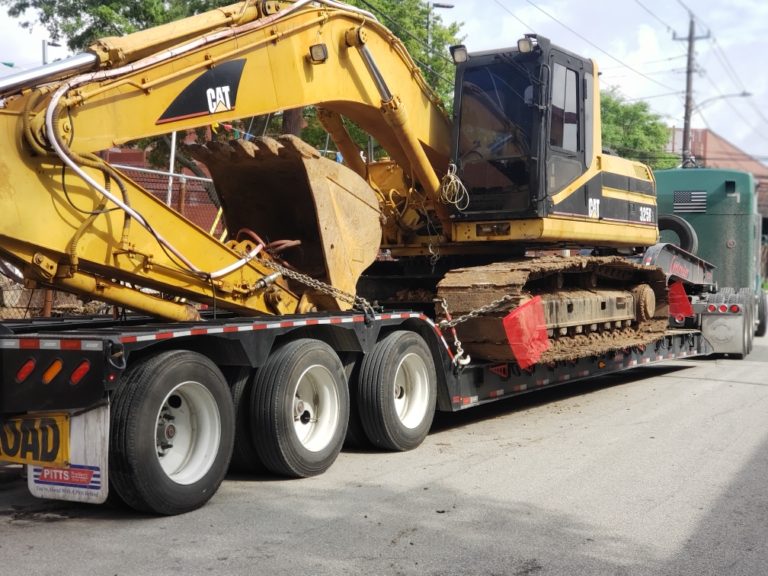Preparing Your Construction Equipment for Transport
Before you can begin preparing your construction equipment transport, you’ll need to select the trailer on which it will ride. You can prepare your equipment properly once you know which type of trailer it fits. Sometimes, to make your equipment fit on a less expensive type of trailer, you’ll need to remove pieces from your machinery.
Height usually is the problem. Flatbeds are about five feet off the ground. Most states allow you 13 ½ feet of total clearance. That leaves you with 8 ½ feet or so in height for your equipment, a little more in some states. Step deck trailers, which have middle sections that ride lower to the ground, offer maybe another two feet in clearance.
If your load is too tall using a step deck trailer for transport, you can gain more clearance by replacing the step-deck trailer with a lowboy trailer. You can get another foot or so in legal height by switching to a lowboy trailer. Lowboys cost more than step decks, so you only want to use a lowboy when you need it.
Once you know which type of trailer you’re using, you can begin preparing your construction equipment for transport. Position any booms properly, retracting them so they don’t affect height or length. Remove attachments that might make you oversized. In some states, it’s illegal to ship your equipment with a bucket or scoop attached. Ask your transport representative for any special rules in the states your cargo will travel.

Avoiding Wide Load Designation for Your Construction Equipment
Only your largest pieces of construction equipment travel as wideloads. Off-road dump trucks, cranes, excavators, dozers, graders and scrapers – all are candidates for oversize designation. Most other types of construction machinery should fit within dimensional regulations.
Remove attachments from bulldozers and wheel loaders to make them fit within regulations. It’s often cheaper, and more efficient, to ship the attachment separately rather than travel as an oversize load. Tips for avoiding wide load designation include:
- Overheight: Retract, or even remove, the boom or the bucket. Sometimes it’s worth another load to avoid wideload designation.
- Overweight: Shipping the body separate from the attachments reduces the weight. Anything over 40,000 pounds is pushing the limit.
- Overwidth: Not much you can do here. Most construction equipment runs on tracks, not tires. It’s not worth the effort to remove the tracks.
- Overlength: Most states give you 53 feet in length, usually more than enough. If your machine is too long, remove something or wideload.
Do everything you can to avoid a wideload load designation. It can double or triple your cost, depending on how much oversized your load is and whether or not you need escort vehicles. As much as you hate to tear your machine apart, reducing its size to fit within dimensional regulations is worth it.
Prepare Your Heavy Equipment for Transport
Check your equipment owner’s manual for specific instructions on how to prepare your machinery for transport. Look for anything that might break off during transport and wrap it with bubble wrap. Levers, knobs or gauges, it’s a lot cheaper to wrap them than replace them.
Do you want the driver to drive your equipment onboard the trailer? Most drivers know how to operate construction equipment. They make their living hauling heavy equipment. But if you’d feel better with one of your guys doing the loading, make sure you schedule it.
Tips for preparing your construction equipment for transport include:
- Cover the stack. Prevent unwanted debris from floating down the smokestack on your machine by covering it before transport.
- Disconnect the battery. You want your equipment to start when you arrive. As a precaution, unhook batteries so they don’t get drained.
- Latch the doors. Doors will flap in the wind if they’re not properly closed. If the door latch won’t work, zip tie the door shut.
- Wash the machine. Dirt and debris can obscure handholds and tie-down points. Also, hard to notice new damage when it’s dirty.
- If your equipment is traveling as an oversize load, you’ll need safety banners, lights and signs. Check with your transportation agent, they should be prepared to provide everything needed. Ask for photos of the transport that shows all the safety equipment has been deployed.
Typically, the maximum legal weight of a step deck is 48,000lbs. Step deck trailing towing can also be used to transport cargo that meets the following maximum dimensions: 48ft – 53ft length if using an extended trailer, 8.5ft width, and 10ft – 11ft height.
Get Your Construction Equipment Transport Quote Now!
Step 1: Fill Out Quote Form
Fill out the short & easy quote form.
Step 2: Speak With An Agent
We’ll pick up your heavy equipment or vehicle.
Step 3: Get Transported On Time
We deliver on time so you can get back to work.